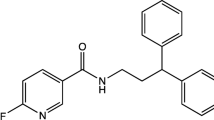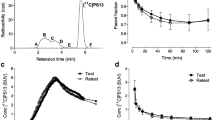Abstract
Purpose
Soluble epoxide hydrolase (sEH) is an enzyme that shapes immune signaling through its role in maintaining the homeostasis of polyunsaturated fatty acids and their related byproducts. [18F]FNDP is a radiotracer developed for use with positron emission tomography (PET) to image sEH, which has been applied to imaging sEH in the brains of healthy individuals. Here, we report the test–retest repeatability of [18F]FNDP brain PET binding and [18F]FNDP whole-body dosimetry in healthy individuals.
Methods
Seven healthy adults (4 men, 3 women, ages 40.1 ± 4.6 years) completed [18F]FNDP brain PET on two occasions within a period of 14 days in a test–retest study design. [18F]FNDP regional total distribution volume (VT) values were derived from modeling time-activity data with a metabolite-corrected arterial input function. Test–retest variability, mean absolute deviation, and intraclass correlation coefficient (ICC) were investigated. Six other healthy adults (3 men, 3 women, ages 46.0 ± 7.0 years) underwent [18F]FNDP PET/CT for whole-body dosimetry, which was acquired over 4.5 h, starting immediately after radiotracer administration. Organ-absorbed doses and the effective dose were then estimated.
Results
The mean test–retest difference in regional VT (ΔVT) was 0.82 ± 5.17%. The mean absolute difference in regional VT was 4.01 ± 3.33%. The ICC across different brain regions ranged from 0.92 to 0.99. The organs with the greatest radiation-absorbed doses included the gallbladder (0.081 ± 0.024 mSv/MBq), followed by liver (0.077 ± 0.018 mSv/MBq) and kidneys (0.063 ± 0.006 mSv/MBq). The effective dose was 0.020 ± 0.003 mSv/MBq.
Conclusion
These data support a favorable test–retest repeatability of [18F]FNDP brain PET regional VT. The radiation dose to humans from each [18F]FNDP PET scan is similar to that of other 18F-based PET radiotracers.


Similar content being viewed by others
Data availability
The datasets generated during and/or analyzed during the current study are available from the corresponding author upon reasonable request.
Code availability
Not applicable.
References
Zarriello S, Tuazon JP, Corey S, Schimmel S, Rajani M, Gorsky A, Incontri D, Hammock BD, Borlongan CV. Humble beginnings with big goals: small molecule soluble epoxide hydrolase inhibitors for treating CNS disorders. Prog Neurobiol. 2019;172:23–39. https://doi.org/10.1016/j.pneurobio.2018.11.001.
Hung YW, Hung SW, Wu YC, Wong LK, Lai MT, Shih YH, Lee TS, Lin YY. Soluble epoxide hydrolase activity regulates inflammatory responses and seizure generation in two mouse models of temporal lobe epilepsy. Brain Behav Immun. 2015;43:118–29. https://doi.org/10.1016/j.bbi.2014.07.016.
Ren Q, Ma M, Ishima T, Morisseau C, Yang J, Wagner KM, Zhang J-C, Yang C, Yao W, Dong C, Han M, Hammock BD, Hashimoto K. Gene deficiency and pharmacological inhibition of soluble epoxide hydrolase confers resilience to repeated social defeat stress. Proc Natl Acad Sci U S A. 2016;113(13):E1944–52. https://doi.org/10.1073/pnas.1601532113.
Ren Q, Ma M, Yang J, Nonaka R, Yamaguchi A, Ishikawa K-I, Kobayashi K, Murayama S, Hwang SH, Saiki S, Akamatsu W, Hattori N, Hammock BD, Hashimoto K. Soluble epoxide hydrolase plays a key role in the pathogenesis of Parkinson’s disease. Proc Natl Acad Sci U S A. 2018;115(25):E5815–23. https://doi.org/10.1073/pnas.1802179115.
Shinto LH, Raber J, Mishra A, Roese N, Silbert LC. A review of oxylipins in Alzheimer’s disease and related dementias (ADRD): potential therapeutic targets for the modulation of vascular tone and inflammation. Metabolites. 2022;12(9). https://doi.org/10.3390/metabo12090826.
Horti AG, Wang Y, Minn I, Lan X, Wang J, Koehler RC, Alkayed NJ, Dannals RF, Pomper MG. 18F-FNDP for PET imaging of soluble epoxide hydrolase. J Nucl Med. 2016;57(11):1817–22. https://doi.org/10.2967/jnumed.116.173245.
Du Y, Minn I, Foss C, Lesniak WG, Hu F, Dannals RF, Pomper MG, Horti AG. PET imaging of soluble epoxide hydrolase in non-human primate brain with [(18)F]FNDP. EJNMMI Res. 2020;10(1):67. https://doi.org/10.1186/s13550-020-00657-7.
Coughlin JM, Slania S, Du Y, Shinehouse LK, Brosnan MK, Azad BB, Holt DP, Fan H, Lesniak WG, Minn I, Rowe SP, Dannals RF, Horti AG, Pomper MG. First-in-human neuroimaging of soluble epoxide hydrolase using [(18)F]FNDP PET. Eur J Nucl Med Mol Imaging. 2021;48(10):3122–8. https://doi.org/10.1007/s00259-021-05231-4.
Mori S, Wu D, Ceritoglu C, Li Y, Kolasny A, Vaillant MA, Faria AV, Oishi K, Miller MI. MRICloud: delivering high-throughput MRI neuroinformatics as cloud-based software as a service. Comput Sci Eng. 2016;18(5):21–35. https://doi.org/10.1109/MCSE.2016.93.
Azad BB, Holt DP, Ravert HT, Horti AG, Dannals RF. An optimized radiosynthesis of [(18) F]FNDP, a positron emission tomography radiotracer for imaging soluble epoxide hydrolase (sEH). J Labelled Compd Radiopharm. 2018;61(7):567–72. https://doi.org/10.1002/jlcr.3620.
Rahmim A, Cheng JC, Blinder S, Camborde ML, Sossi V. Statistical dynamic image reconstruction in state-of-the-art high-resolution PET. Phys Med Biol. 2005;50(20):4887–912. https://doi.org/10.1088/0031-9155/50/20/010.
Coughlin JM, Du Y, Rosenthal HB, Slania S, Min Koo S, Park A, Solomon G, Vranesic M, Antonsdottir I, Speck CL, Rootes-Murdy K, Lerner A, Rowe SP, Wang Y, Lesniak WG, Minn I, Bakker A, Smith GS, Dannals RF, Kuwabara H, Horti A, Wong DF, Pomper MG. The distribution of the alpha7 nicotinic acetylcholine receptor in healthy aging: an in vivo positron emission tomography study with [(18)F]ASEM. Neuroimage. 2018;165:118–24. https://doi.org/10.1016/j.neuroimage.2017.10.009.
Innis RB, Cunningham VJ, Delforge J, Fujita M, Gjedde A, Gunn RN, Holden J, Houle S, Huang SC, Ichise M, Iida H, Ito H, Kimura Y, Koeppe RA, Knudsen GM, Knuuti J, Lammertsma AA, Laruelle M, Logan J, Maguire RP, Mintun MA, Morris ED, Parsey R, Price JC, Slifstein M, Sossi V, Suhara T, Votaw JR, Wong DF, Carson RE. Consensus nomenclature for in vivo imaging of reversibly binding radioligands. J Cereb Blood Flow Metab. 2007;27(9):1533–9. https://doi.org/10.1038/sj.jcbfm.9600493.
Logan J, Fowler JS, Volkow ND, Wolf AP, Dewey SL, Schlyer DJ, MacGregor RR, Hitzemann R, Bendriem B, Gatley SJ, et al. Graphical analysis of reversible radioligand binding from time-activity measurements applied to [N-11C-methyl]-(-)-cocaine PET studies in human subjects. J Cereb Blood Flow Metab. 1990;10(5):740–7. https://doi.org/10.1038/jcbfm.1990.127.
Stabin MG, Sparks RB, Crowe E. OLINDA/EXM: the second-generation personal computer software for internal dose assessment in nuclear medicine. J Nucl Med. 2005;46(6):1023–7.
Zanotti-Fregonara P, Lammertsma AA, Innis RB. 11C dosimetry scans should be abandoned. J Nucl Med. 2021;62(2):158–9.
Acknowledgements
This research was supported by NIH grants R33AG054802 and P41EB024495 (AGH, MGP).
The authors would like to thank Dr. Scott Mittman for the expert provision of arterial catheterization and the technical staff within the Johns Hopkins PET Center.
Funding
This work was supported by the National Institutes of Health [AG054802 and EB024495 (AGH and MGP)].
Author information
Authors and Affiliations
Contributions
YD, JMC, AA, AGH, MAL, SPR, and MGP jointly developed the concept of the manuscript. JMC, SES, CH, MKB, AZ, LKS, AR, RA, and LBS led the data acquisition. YD, AA, and MAL analyzed these imaging data. AA and MAL performed dosimetry calculations. DH, HF, WGL, AN, RFD, and AGH jointly completed each radiotracer synthesis, as well as the measurement and critical evaluation of radiotracer dynamic behavior in blood plasma. All authors were involved in the writing and proofreading of the manuscript.
Corresponding author
Ethics declarations
Ethics approval and consent to participate
All procedures performed in studies involving human participants were in accordance with the ethical standards of the institutional and/or national research committee and with the 1964 Helsinki Declaration and its later amendments or comparable ethical standards. This article does not contain any studies involving animals. The study was approved by the Johns Hopkins Investigational Review Board and Radiation Safety Committees. All subjects provided written informed consent.
Consent for publication
Not applicable.
Competing interests
AGH and MGP are co-inventors on a U.S. patent covering [18F]FNDP and, as such, are entitled to a portion of any licensing fees and royalties generated by this technology. JMC is the spouse of MGP. AGH, SPR, and MGP are consultants for Precision Molecular, Inc., which have licensed [18F]FNDP. This arrangement has been reviewed and approved by the Johns Hopkins University in accordance with its conflict-of-interest policies. All other authors have no relevant financial or non-financial interests to disclose.
Additional information
Publisher's note
Springer Nature remains neutral with regard to jurisdictional claims in published maps and institutional affiliations.
Supplementary Information
Below is the link to the electronic supplementary material.
Rights and permissions
Springer Nature or its licensor (e.g. a society or other partner) holds exclusive rights to this article under a publishing agreement with the author(s) or other rightsholder(s); author self-archiving of the accepted manuscript version of this article is solely governed by the terms of such publishing agreement and applicable law.
About this article
Cite this article
Du, Y., Coughlin, J.M., Amindarolzarbi, A. et al. [18F]FNDP PET neuroimaging test–retest repeatability and whole-body dosimetry in humans. Eur J Nucl Med Mol Imaging 50, 3659–3665 (2023). https://doi.org/10.1007/s00259-023-06331-z
Received:
Accepted:
Published:
Issue Date:
DOI: https://doi.org/10.1007/s00259-023-06331-z




